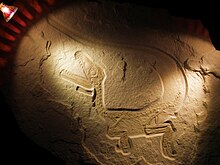Sciurumimus
| Sciurumimus | |
|---|---|

| |
| The juvenile type specimen | |
| Scientific classification | |
| Domain: | Eukaryota |
| Kingdom: | Animalia |
| Phylum: | Chordata |
| Clade: | Dinosauria |
| Clade: | Saurischia |
| Clade: | Theropoda |
| Clade: | Orionides |
| Genus: | †Sciurumimus Rauhut et al., 2012 |
| Species: | †S. albersdoerferi
|
| Binomial name | |
| †Sciurumimus albersdoerferi Rauhut et al., 2012
| |
Sciurumimus ("Squirrel-mimic," named for its tail's resemblance to that of the tree squirrel, Sciurus[1]) is an extinct genus of tetanuran theropod from the Late Jurassic Torleite Formation of Germany. It is known from a single juvenile specimen representing the type species, Sciurumimus albersdoerferi, which was found in a limestone quarry close to Painten in Lower Bavaria.[2] The specimen was preserved with traces of feather-like filaments.[3]
The Sciurumimus specimen was first announced in an informal presentation by Rauhut and Foth (2011),
Description

Sciurumimus is known from a single holotype fossil that is exceptionally well-preserved, with full skeleton in complete articulation along with fine details of soft tissue. It is comparable in size and proportions to the juvenile coelurosaur Juravenator, although differs significantly in several anatomical details. The skull of Sciurumimus is proportionally large, at 156% of the length of the femur and longer than the cervical vertebrae series. These body proportions, along with short forelimbs, lack of fusion in the skeleton, and regular tooth morphology indicate the specimen represents a very young, probably early-posthatchling individual.[2]
The fossil preserves filamentous plumage at the tail base and on other parts of the body. These structures are described as being identical to the
Classification

When first discovered, a phylogenetic analysis suggested that Sciurumimus may have been a primitive member of the Megalosauroidea, a clade of large carnivorous dinosaurs more primitive than many other well-known theropods like the
This initial study was criticized by several researchers, who noted that some of the old analyses the scientists used to plug in data from the new fossil were incomplete and missing relevant data on various species.
Andrea Cau, in 2024, recovered Sciurumimus, along with Compsognathus and Scipionyx all within different positions within Megalosauroidea. [6]
Here is a simplified phylogeny of Cau (2024) with Sciurumimus in bold.
| Tetanurae |
| ||||||||||||||||||||||||||||||||||||||||||||||||||||||||||||||||||||||||||||||||||||||||||
References
- ^ "Newly Discovered Dinosaur Implies Greater Prevalence of Feathers". American Museum of Natural History. July 2, 2012. Retrieved February 2, 2019.
- ^ PMID 22753486.
- S2CID 123219913.
- ^ Rauhut and Foth, (2011). New information on Late Jurassic theropod dinosaurs from Southern Germany. IV Congresso Latinoamericano Paleontologia de Vertebrados.
- ^ PMID 31333906.
- ^ .
- S2CID 245820672.
- ^ Mortimer, M. 2013. "Coelurosauria Archived 2013-09-29 at the Wayback Machine", The Theropod Database. Accessed online 09-AUG-2013.http://archosaur.us/theropoddatabase/Coelurosauria.htm#Sciurumimusalbersdoerferi
- ^ Mortimer, M. and Marjanovic, D. (in prep.) http://archosaur.us/theropoddatabase/Coelurosauria.htm#Sciurumimusalbersdoerferi Archived 2013-09-29 at the Wayback Machine
- S2CID 4364892.
- S2CID 56480710.
- S2CID 174811556.
- ISBN 978-0-691-16766-4.
- S2CID 216245045, retrieved 2020-11-12
